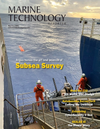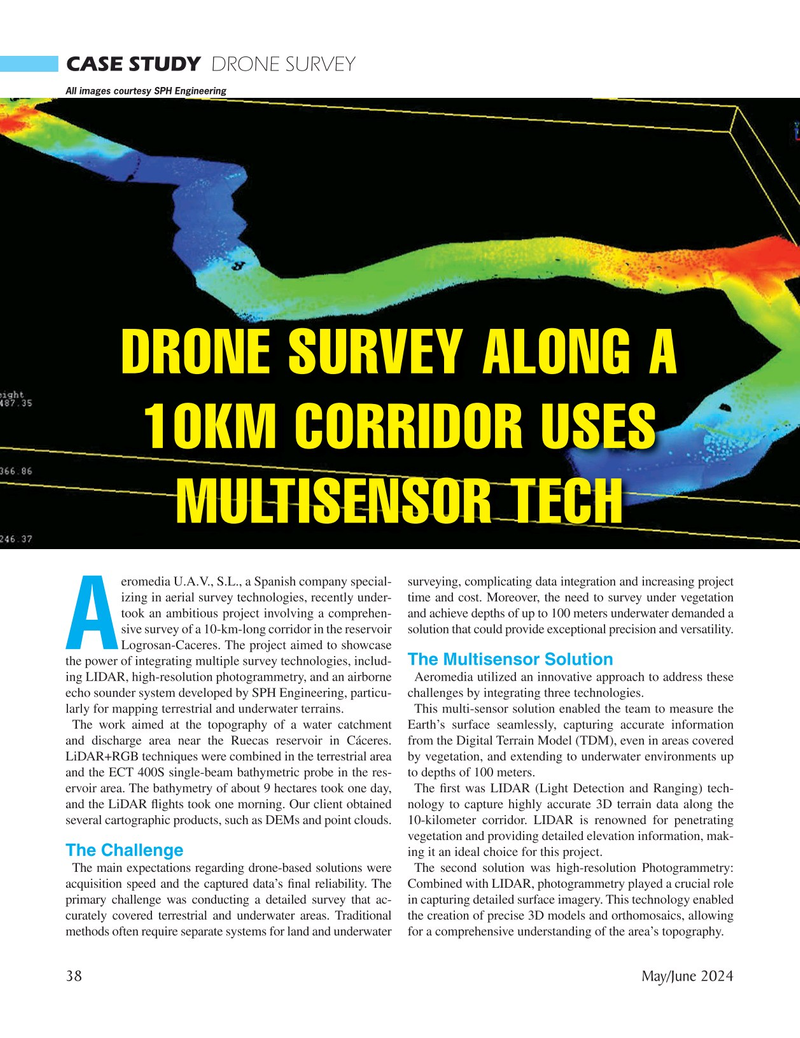
Page 38: of Marine Technology Magazine (May 2024)
Read this page in Pdf, Flash or Html5 edition of May 2024 Marine Technology Magazine
CASE STUDY DRONE SURVEY
All images courtesy SPH Engineering
DRONE SURVEY ALONG A 10KM CORRIDOR USES
MULTISENSOR TECH eromedia U.A.V., S.L., a Spanish company special- surveying, complicating data integration and increasing project izing in aerial survey technologies, recently under- time and cost. Moreover, the need to survey under vegetation took an ambitious project involving a comprehen- and achieve depths of up to 100 meters underwater demanded a sive survey of a 10-km-long corridor in the reservoir solution that could provide exceptional precision and versatility.
A Logrosan-Caceres. The project aimed to showcase the power of integrating multiple survey technologies, includ- The Multisensor Solution ing LIDAR, high-resolution photogrammetry, and an airborne Aeromedia utilized an innovative approach to address these echo sounder system developed by SPH Engineering, particu- challenges by integrating three technologies. larly for mapping terrestrial and underwater terrains. This multi-sensor solution enabled the team to measure the
The work aimed at the topography of a water catchment Earth’s surface seamlessly, capturing accurate information and discharge area near the Ruecas reservoir in Cáceres. from the Digital Terrain Model (TDM), even in areas covered
LiDAR+RGB techniques were combined in the terrestrial area by vegetation, and extending to underwater environments up and the ECT 400S single-beam bathymetric probe in the res- to depths of 100 meters.
ervoir area. The bathymetry of about 9 hectares took one day, The ? rst was LIDAR (Light Detection and Ranging) tech- and the LiDAR ? ights took one morning. Our client obtained nology to capture highly accurate 3D terrain data along the several cartographic products, such as DEMs and point clouds. 10-kilometer corridor. LIDAR is renowned for penetrating vegetation and providing detailed elevation information, mak-
The Challenge ing it an ideal choice for this project.
The main expectations regarding drone-based solutions were The second solution was high-resolution Photogrammetry: acquisition speed and the captured data’s ? nal reliability. The Combined with LIDAR, photogrammetry played a crucial role primary challenge was conducting a detailed survey that ac- in capturing detailed surface imagery. This technology enabled curately covered terrestrial and underwater areas. Traditional the creation of precise 3D models and orthomosaics, allowing methods often require separate systems for land and underwater for a comprehensive understanding of the area’s topography.
38 May/June 2024
MTR #4 (34-47).indd 38 6/2/2024 11:46:58 AM

 37
37

 39
39
